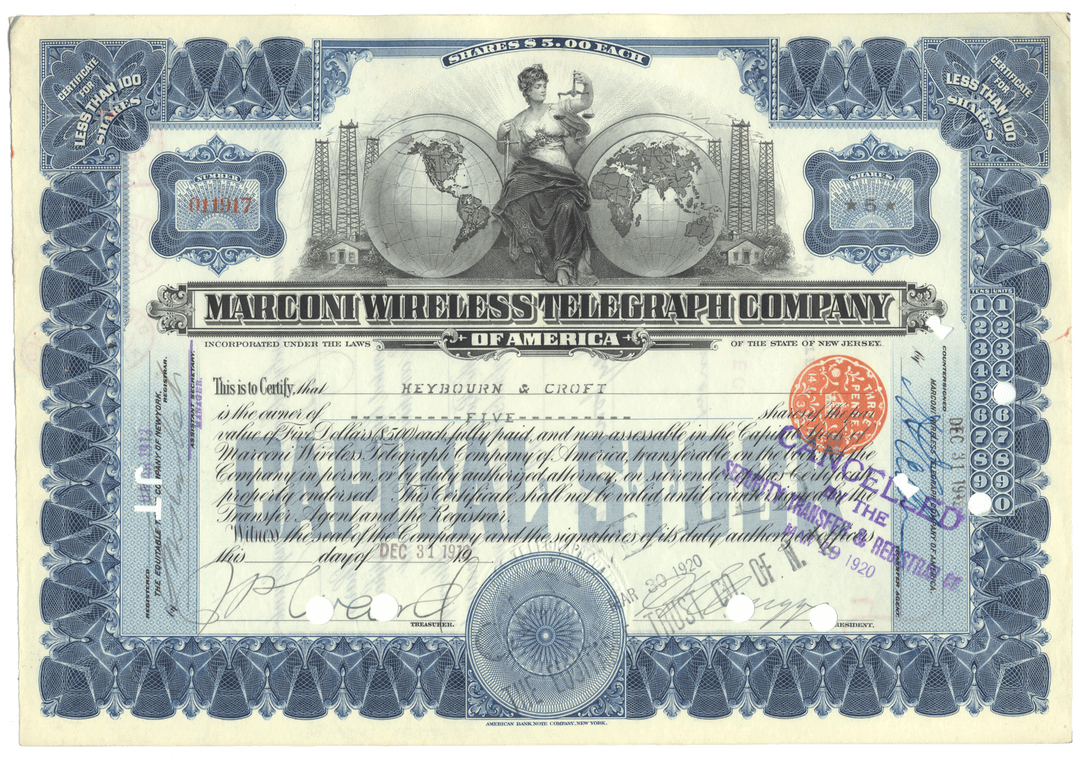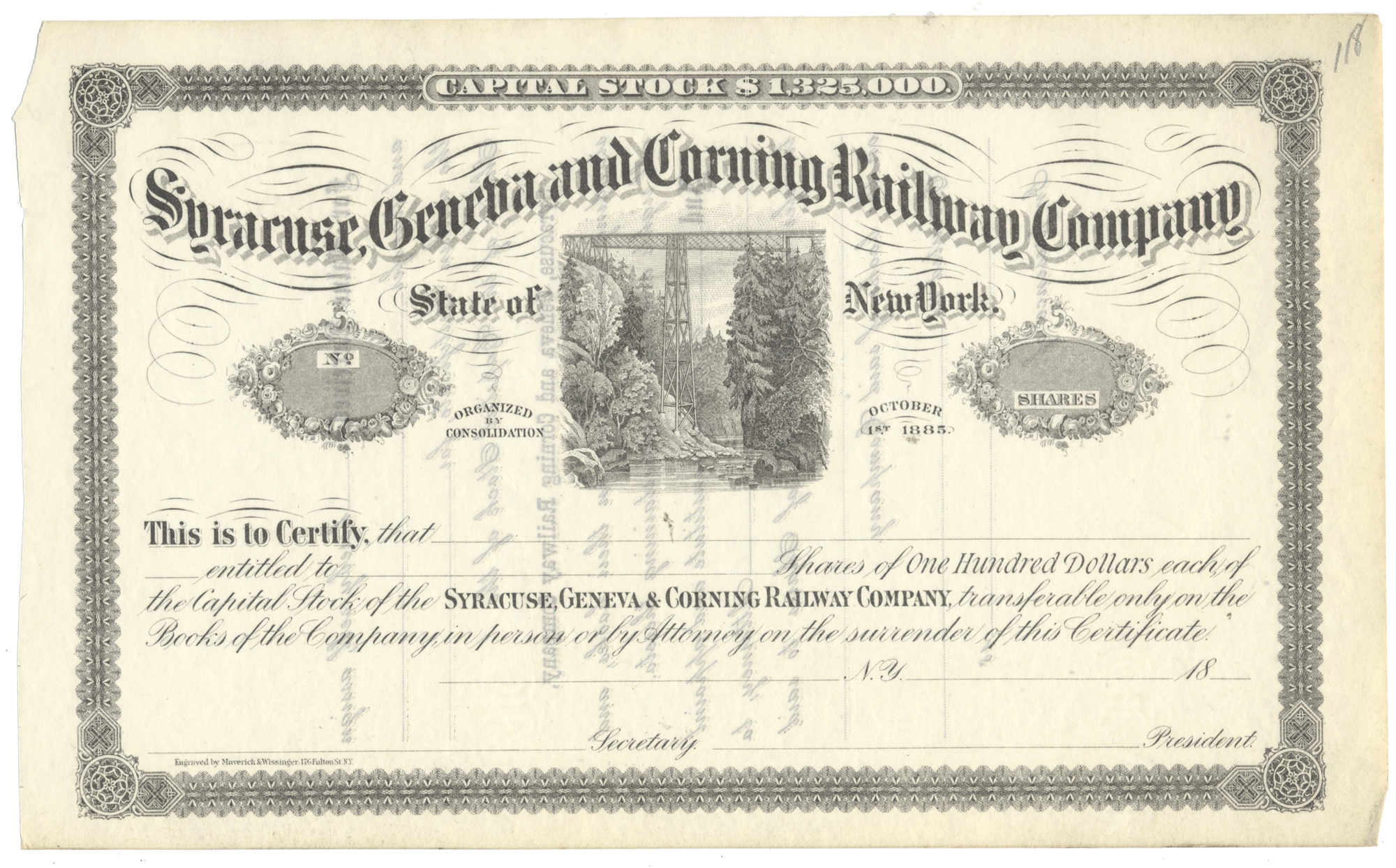
Marconi Wireless Telegraph Company of America
- Guaranteed authentic document
- Orders over $75 ship FREE to U. S. addresses
Product Details
| Company | Marconi Wireless Telegraph Company of America |
| Certificate Type | Capital Stock |
| Date Issued | 1910's |
| Canceled | Yes |
| Printer | American Bank Note Company |
| Signatures | Hand signed |
| Approximate Size |
11 3/4" (w) by 8" (h) |
|
Product Images |
Representative of the piece you will receive |
| Authentic | Yes |
| Additional Details | NA |
Historical Context
In 1894, across the Atlantic in Bologna Italy, a young man by the name of Guglielmo Marconi, began experimenting with Electromagnetic Waves (Radio Waves). In an unused portion of his parent’s attic, Marconi constructed devices for sending and receiving Morse code across the room without the use of wires. Through trial and error Marconi steadily improved the distances he was able to send a signal and soon outgrew his attic laboratory. Within a year, Marconi was able to transmitting a telegraph signal a distance of two miles. By 1897, Marconi had increased the distance to 15 miles, proving that man-made and natural obstacles did not interfere with the transmission of radio waves. Professor Hugh Aitken succinctly describes Marconi’s pivotal achievement in the development of radio: "...he was at the culmination of the process whereby a major scientific advance was translated into practical use. Scientific theorem had already been translated into apparatus ... [which] could be used for tests and demonstrations...Marconi carried it one step further. He translated laboratory hardware into a technological system that could serve practical needs." In Aitken's view, although many of Marconi's contemporaries were experimenting with the waves discovered by physicist Heinrich Hertz, Marconi's genius was in foreseeing the practical potential of radio transmission.
In 1896, Marconi returned to his mother’s native England, and established the Wireless Telegraphic and Signaling Company of England. His company provided Ship-to-Ship and Ship-to-Shore Wireless Telegraphy, the principal application of Marconi’s wireless, which was immediately recognized as significantly increasing the safety of marine transportation.
Marconi’s successes were rapid. In 1899, he successfully transmitted radio waves across the English Channel. In the same year, he was granted the English patent number 7777, the first radio patent ever issued. Marconi then sailed to the United States and used a ship-based wireless transmitter to report on the America’s Cup race. Soon after his arrival in the US, Marconi established the Marconi Wireless Telegraph Company of America and pursued two major goals. His first goal, a commercial radio empire, was achieved through a series of successful patent lawsuits against his competitors. As a result the Marconi Company emerged as the dominant player in this new field of Radiotelegraphy.
Marconi’s second goal was to push the boundary of excepted scientific theory and transmit radio signals across the Atlantic. From his bases in Cape Cod and Cornwall, Marconi labored to cross the Atlantic. He succeeded in 1901 by moving his receiving base to Newfoundland and using a kite-supported antenna. Over the next several years, Marconi endeavored to not only to improve reliability and continuity of this signal but to also increase transmission distances even further. By 1907, the Americas and Europe were in regular commercial communication. The success of his transoceanic experiments led the American and British Marconi companies to project an ambitious plan to establish a worldwide high-power communications system. These high-power stations would girdle the world and provide virtually instantaneous communications to every point on the globe. In 1909, Marconi was awarded the Noble Prize for Physics adding to his already substantial fame. Three years later Marconi would be credited with saving the 712 survivors of the Titanic disaster.
In 1912, a lawsuit against United Wireless resulted in the merger of the two companies. Among the assets acquired by Marconi were 70 land stations and more then 500 ship-board installations. One of these stations was Station KPH, San Francisco's first radio station. In 1913, a new site was purchased and construction begun for the station’s new home.
Related Collections
Additional Information
Certificates carry no value on any of today's financial indexes and no transfer of ownership is implied. All items offered are collectible in nature only. So, you can frame them, but you can't cash them in!
All of our pieces are original - we do not sell reproductions. If you ever find out that one of our pieces is not authentic, you may return it for a full refund of the purchase price and any associated shipping charges.





